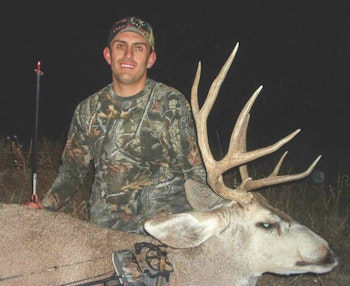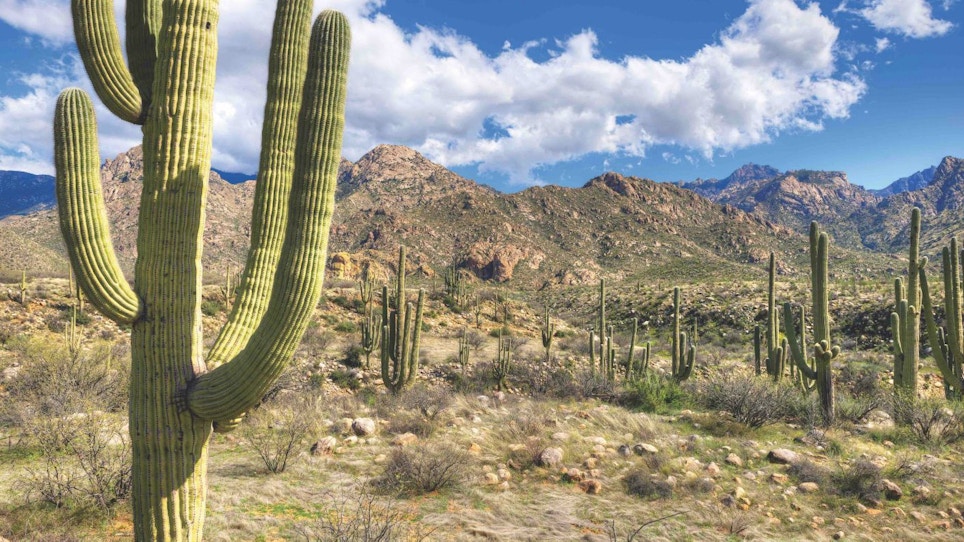Bowhunters in North America are a lucky bunch. Not only do we have the best opportunities in the world to chase a variety of game on public ground, but if you look hard enough, you can find a game animal to match wits with virtually every month of the year. I’ll admit, like most bowhunters across our glorious landscape, I generally have my bow put away for the season by the time late December and January roll around. However, deep in the southwest reaches of the Lower 48 lives a special breed of bowhunters who are still at it while most of us are warming by a winter fire.
For the whitetail enthusiast, there is perhaps no greater challenge than matching wits with the Coues whitetail of the Southwest. Don’t be fooled by these pint-sized desert whitetails. Although a mature buck won’t touch 100 pounds wet, they are cunning, crafty and always seem to be on alert.
And if mule deer are your fancy, a late-season mule deer hunt in the desert Southwest can also be on the agenda. Although when most bowhunters think about the giant mule deer of the Southwest, their thoughts turn to the famed Kaibab and Strip country of the northern half of Arizona. However, the desert mule deer farther south are also an impressive trophy. They may not have the enormous headgear of their northern Rocky Mountain cousins, but the challenge of a desert mule deer hunt will more than make up for the missing headbone.

Arizona Desert Dwellers
Even though both of these desert gems can be found in New Mexico and Old Mexico in solid numbers, the Grand Canyon State is king when it comes to finding success for the DIY bowhunter. With tags available over-the-counter for just a few Benjamins, as well as solid numbers of both Coues deer and mule deer that roam across vast amounts of public ground, it’s hard to beat the DIY desert rat opportunities found there.
For over 15 years, Steve Ward has operated Wards Outfitters in Arizona and Old Mexico. Although he offers exceptional hunts for Arizona’s famed Rocky Mountain elk, as well as javelina and Gould’s turkey, he specializes in bowhunting the Coues whitetail and desert mule deer of these vast regions. As an outfitter, his clients have killed more than 300 Coues deer with a bow, and the mule deer population his clients have pursued haven’t fared much better either during that timeframe.
“At first glance, this country seems overwhelming,” Steve said. “It is so vast and rugged that the average bowhunter does not know where to begin most of the time. However, if you can do a little homework before you arrive, and are willing to spend an ample amount of time behind the glass searching and pounding the ground, then it won’t be long before you are able to put a plan together for either of these desert prizes.”
For someone looking to check the Coues whitetail off their bucket list, Steve says there are two primary times in which to slip into bow range: during the early season that runs from late-August through mid-September, and then the rut that takes place from late-December through January. Although each of these time periods can yield a bomber Coues buck, according to Steve, the rut can offer fast action that any eastern whitetail hunter would love.

Coues Tactics
Although the Coues whitetail has earned a reputation as being one of the toughest deer to kill with a bow in North America, according to Steve, it’s really all about adapting to the terrain and using standard whitetail tactics to the bowhunter’s advantage. Simply put, if you are hunting during the early season, focusing on water, minerals and travel corridors is a good bet. During the rut, adding rattling and grunt calls to the mix can bring a buck running.
During the early season, Steve’s typical tactic is to use a spot-and-ambush approach in the mornings and evenings, and then sit at a water or mineral source from mid-morning to mid-afternoon. The spot-and-ambush tactic requires finding a bachelor group of bucks moving from feeding to bedding areas and then attempting to ambush them in a likely travel corridor. “Bucks can be fairly patternable this time of year,” Steve said, “so you’re likely to see the same group of bucks every day if you glass a specific area hard enough.”
When it comes to finding success guarding water, you have to be diligent, insists Steve. Even though you are hunting desert country, you generally will not see Coues deer hitting the same water source daily. If there is a particular buck you are after that was revealed to you via trail camera, it’s best to sit all day for several days. The same tactic can be used when hunting over minerals. However, keep in mind that bucks generally hit minerals less as the season progresses because they are not needed anymore. On the other hand, if it’s a location that was seeing a lot of doe activity, you should keep them in mind when the ruts kicks in. Lactating does need minerals throughout the season.
Obviously, locating a water source in these high and low desert regions can be a daunting task. Although physically scouting areas can help yield this liquid gold, Steve says the most efficient way is to utilize Google Earth. “Simply set the date ranges in the timeline between May and June, which is the driest time of year in the Southwest, and look for the lush green spots. They will usually be located in canyons and may not be as obvious as you may think. However, if you can locate a permanent water source or two, regardless of the season you are planning to hunt, good numbers of both Coues deer and mule deer could very well be using it.”
Rut Power!
As mentioned previously, the Coues deer rut generally kicks off in late-December and runs through January. One of the most effective tactics Steve employs during this crazy love season is using rattling and/or grunting techniques to bring an aggressive buck into range. Ideally, he likes to locate an unsuspecting buck bedded or dogging a hot doe and slip to within 80 to 100 yards and crash the horns together. Coues bucks tend to be more aggressive by nature, and it usually doesn’t take much to get one to come in to investigate.
Guarding large community scrapes can also be effective during the initial phase of the rut. These tend to be hubs for both buck and doe activity and can be great locations to capitalize on a buck on the move. “Don’t overlook water this time of year, either,” Steve said, “especially if it’s a really dry year. Bucks will be on their feet throughout the day searching for and running does, and water will be a necessity.”
For the mule deer freak, the season structure is similar to that of the Coues, and with the over-the-counter tag being good for either species, you can hop from one species to another if the opportunity arises. Desert mule deer and Coues deer country does overlap in many areas. That being said, although the seasons are similar, tactics are a little different.
When it comes to hunting water, Steve sees less consistency with mule deer hitting a specific water source day in and day out. However, if trail cameras reveal a particular buck is hitting one regularly, don’t be afraid to put in the man hours.

Desert Muley Tips
Bowhunting the early season requires long hours behind the glass spotting bachelor groups of bucks. Once located, put them to bed and develop a plan to slip into bow range. The difficult task in this process is locating the buck you’re willing to wrap your tag around. The southwest desert is vast, and bucks aren’t located in every basin or flat. As Steve puts it, “You have to be willing to pound the ground, searching for the particular buck you’re after. Keep in mind as well that a desert muley typically won’t have the headgear their Rocky Mountain cousins boast. Although 180-inch bucks are killed every season, and you should certainly hunt a buck like that until you kill him, a buck in the 150-inch range should be a bowhunter’s target if they’re looking for a quality buck.”
During the rut, which kicks into gear in mid-December and begins tailing off in mid-January, mule deer are on the move, so keep track of doe groups. According to Steve, one of the most effective ways to kill a muley buck during the rut is to wait until he splits a hot doe away from the group. There are less eyes then, and with the buck preoccupied with his new girlfriend, you have a better chance of sneaking into bow range.
“Don’t forget to bring a set of rattling antlers, either,” Steve said. “We have brought in a ton of mule deer over the years by both rattling and raking a tree. Although muleys won’t come in looking for a fight like a Coues deer might, the racket of a couple bucks fighting over a hot doe can perk their interest. Simply sneak into that 100-yard range and start making noise.”
Bowhunting the post rut can also be effective if you have a good area. Mature bucks are wore down during this time, and they will often be bedded away from doe groups in recovery mode. According to Steve, they can be super vulnerable during this time, and your chances of slipping into bow range is really good.
Regardless of whether you’re after a bucket list Coues whitetail or an aged desert muley buck, hiring a good guide can pay huge dividends when figuring out their habits in such vast country. Although I’m one who likes the DIY approach most of the time, I certainly wouldn’t be afraid to enlist the help of a good outfitter such as Wards Outfitters to show me the ropes.






